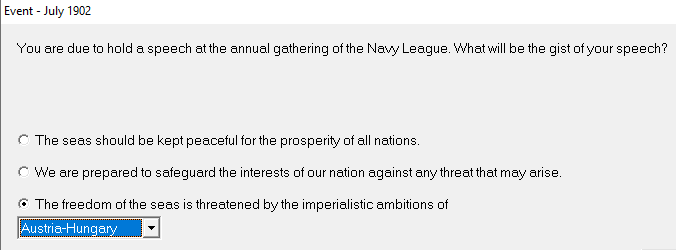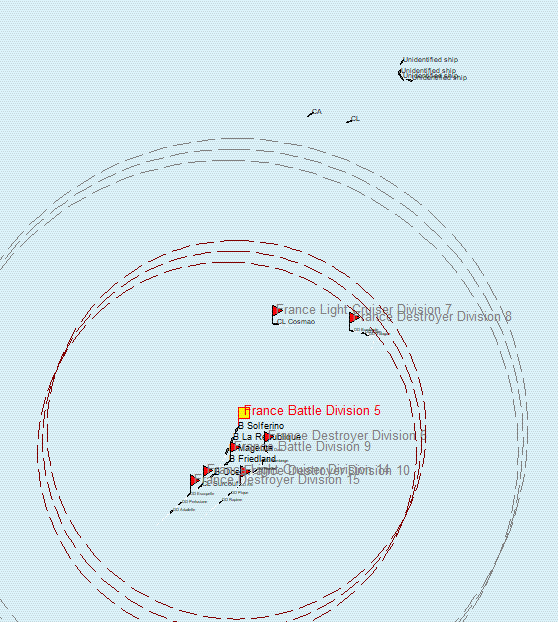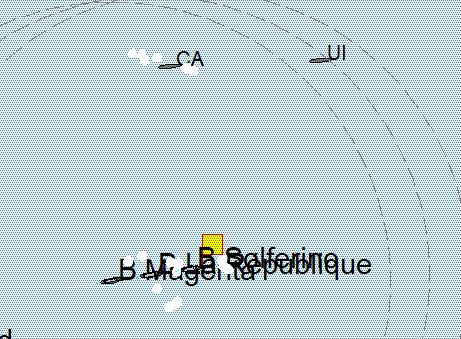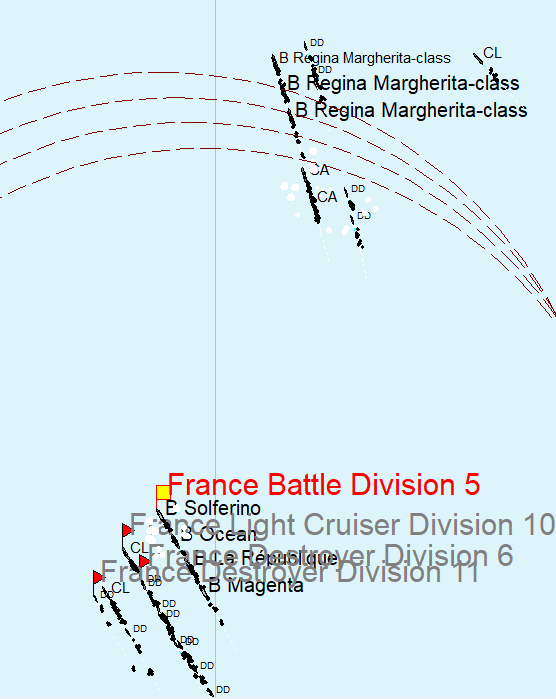Let’s get right to it.
June 1902
Lalande, a Tage, joins the navy, scientists invent the six-foot rangefinder, and naval engineers work out that double bottoms are a good plan (stolen from the Americans).
Strikes delay the construction of Suffren by one month.

Jeers from the naval engineering community lead the Ministère de la Marine to hastily release a slightly more traditional design, with 12″ main guns and six 10″ secondaries. It loses 200 tons and gains a bit of extra armor in the bargain.
Designers play around with some armored cruiser designs, but the naval community eventually rejects the idea.
July 1902

An opportunity arises to hack off our other Mediterranean neighbors. With the budget increase, I lay down another pair of Chateaurenaults, for a total of four under construction.
Italy commissions one of the armored cruisers our spies stole the details of, and invents the early coastal submarine.
August 1902
In response to our hacking off, Austria-Hungary increases its naval spending.
Italy is building more coastal batteries in the Mediterranean, a 6″ and an 11″. The latter might someday cause us trouble.
Coastal batteries might be worth investing in at some point—not for the guns themselves, but because, I believe, the amount of coastal fortification you have increases the extent and density of your defensive minefields.
September 1902
We lay down Trident, first of her class. Linois (a light cruiser) and Epieu (a destroyer) enter service.
October 1902
Tensions with Italy are at the breaking point. War is likely, if any events go in such a fashion as to push us any further.
Italy’s naval budget goes up, and they lay down another armored cruiser.
Our budget, annoyingly, goes slightly down.
November 1902

The Italians are busy this month.
January 1903
We completed research into improved face-hardening, which will improve our future ships’ armor.
March 1903
The new naval minister wants 15 destroyers under construction, and is willing to bump the budget a bit to achieve that, so I take the deal.
April 1904

April 1904: Battle of Crete

The first sea action of la Marine nationale opens on a calm April morning in overcast weather, as the Italians happen upon a French cruiser squadron steaming west-southwest Crete. Visibility should be excellent.
On our side are the two Gueydons based in the Mediterranean, Bruix and Montcalm, six Tages, and seven Fauconneaus. Italy has more cruisers than that in this region, but it remains to be seen how many will come out to play. The sun is rising behind us, which gives our ships a bit of an edge if a battle happens early.
In the event that it looks bad, our squadron, with a speed of 23 knots, should be able to outrun the Italians, the only difficulty being the relative lack of sea room here in the Middle Sea.
5:00
The light cruisers assigned to scouting fan out for a better view.
5:21

The light cruiser Lalande spots a ship ahead. I order a turn to the north-northwest to avoid closing too quickly.
5:24
The light cruisers spot a half dozen ships. I increase the squadron’s speed to 20 knots and pull the scouting force in to screen the armored cruisers.
Two minutes later, Lalande identifies one of the light cruisers as a Salerno class. It bristles with small-caliber guns.

5:27
The light cruisers begin to identify the Italian battle line, which looks to comprise at least four armored cruisers. The squadron stays at 20 knots, pending identification, but we’re probably running.
5:31
Another Italian light cruiser is identified as part of the Nino Bixio class, which is a Salerno without dual-purpose guns.
One minute later, wireless signals from a light cruiser identify one of the enemy ships as a Carlo Alberto-class armored cruiser.

Because the Italians accepted a lower speed, their cruisers get more guns. Because we decided on a higher speed, we don’t need to face them, and Bruix leads Montcalm in a turn east, in pursuit of the better part of valor.
5:36

It’s the right move. Look at that swarm of slow, poorly-armored cruisers!
5:44

This, however, is quite a light cruiser. 6600 tons, 10 6″ guns? Wild. At least it’s slow.
6:06
The Italian battle line cruises past our stern and turns away. The heavy cruisers come about to see if we can’t maybe dispose of a shadowing light cruiser before they come back.
7:36

The red circles represent the range of our cruisers’ main batteries. The larger gray circles represent the edge of their visual range.
I was wary of some manner of trap, but the only ships we can see are the two light cruisers ahead of us, which will shortly be in range. I’m still prepared to run if the rest of the Italian squadron makes an appearance, but it’s looking like we might draw first blood.
7:39
Lalande is the first to open fire.
8:36
The two Italian light cruisers are joined by a third.
Also, it takes us nearly an hour to score a hit: Lalande lands a blow from about 5500 yards.
9:30
The Italian cruiser turns away from its allies, and our fleet sets off in pursuit.
10:29
Regrettably, the Salerno-class target is still alive three hours after the first shot, though burning and badly damaged.
11:17
With the Italian cruiser dead in the water, our ships take one more run past it to ensure it goes under, and depart to the west.
16:35

The scenario ends, as our ships and the enemy’s are far apart. La Marine nationale acquitted itself relatively well in the face of a superior force, escaping serious damage and sinking an enemy ship.
Bruix won the gunnery medal for the day, with a 2.25% hit rate.
April 1903 (cont’d)

The war cancels the naval minister’s ambition for more destroyers, but a new class is in order anyway. These new Francisques don’t sacrifice anything from the preceding Fauconneaus, and have a two-knot speed advantage on them.
Time for wartime dispositions. The Gueydons in the Mediterranean are made commerce raiders. Because of their speed, they’re practically invincible unless caught entirely off guard.
A pair of Chateaurenaults are coming next month. They’ll go on trade protection for a few months, relieving two Tages currently filling that role, until some corvettes currently under construction can take over.
May 1903
A bevy of technologies arrive this month, but none of them are dramatic improvements—lots of slow-and-gradual stuff.
The Italians raid the Northern European coast with three armored cruisers. Three destroyers sally to meet them, but the two forces don’t meet.
Because we don’t have any armored cruisers, the Italians win a bunch of dominance-of-the-sea victories around the Mediterranean. (If the game thinks a battle should happen and one side can’t field appropriate forces, the other side wins by default, as though the under-equipped side had declined battle.) Our commerce raiders and evasion of their coastal raid earn us about the same number of victory points, and in this second month of the war, the tally is 751-623 for the home team.
On the upside, the Chauteaurenault class exceeds its design speed in trials, and hits the same 24-knot mark our existing light cruisers do.
June 1903

Well now. I can live with those odds.
June 1903: The Battle of Bordighera
A leisurely five-hour cruise from Toulon, we encounter the enemy fleet at 8:18 p.m., on a southwesterly course.

The enemy battleships almost immediately turn away.
20:48
After a half an hour of ineffective firing, darkness falls over the Mediterranean.
I’m of a mind to push onward toward the Italian fleet. We have a huge speed advantage, are evenly matched in guns, and have more destroyers (since we’re operating close to our bases). Night fights are bloody, but I think we can make something out of this one.
21:41

Running side-by-side with a trio of perhaps-cruisers-perhaps-battleships at 4,000 yard, Solferino, La République, and Magenta score hit after hit on one of them.
22:51
The Italians bug out toward La Spezia, having dealt some damage to our battleships, and taken some in return. All told, not a bad little battle. La République had a bit of a scare losing electric power and then catching fire, but got both problems under control by 11:30 p.m.
The damage tally calls it a marginal Italian victory. I believe it’s on the strength of Italian gunnery—we scored a lot of hits, but most of them were with the secondary and tertiary batteries on the battleships. The Italians did better with their heavy guns.
July 1903
The government is asking whether to seek peace. I figure we’ll let it go a while longer—they aren’t that far ahead, and we’ll have some submarines joining the fight soon.
July’s battle is a convoy fight. We have a three-ship battle division, three light cruisers, and a bevy of destroyers. Conditions are good, with a moderate breeze, and the sun is high overhead.
Italy brings a similar force: three battleships, a pair of armored cruisers, and some destroyers.

As before, the red circle is the selected squadron’s gun range, and the gray circle is what it can see. Battle Division 5, the lead squadron in the battle line, is selected. Because Light Cruiser Division 10 is out in front of the fleet a little ways, I can still see the transports making their way east by south.
As you probably can’t make out, it’s a tense situation. Let’s break it down a bit.
First, as I mentioned, it’s a daylight battle, so I can’t rely on sunset to mask my convoy from the depredations of the Italian squadron. Second, and of equal importance, the Italians have two squadrons which could seriously threaten the convoy: the battleship squadron, center-left in the picture above, and a cruiser squadron, to their battleships’ southeast.
At the moment of this screenshot, the two battleship squadrons are having an ineffectual gunnery duel—at that range, around 6,000 yards, nobody really expects to hit much. That fight is happening about 30,000 yards west of the transports; I let the Italians pull me off of the convoy, since their cruisers were shadowing their battleships. Eventually, the cruisers peeled off and headed back for the convoy, at which point the speed of the French battle line paid off—we could make it back to the convoy quickly enough to prevent the Italians from doing very much damage to it.
Unfortunately, I didn’t take many pictures of what was by far the most exciting battle to date. The Italians did heavy damage to one of our destroyers, but we did more damage to their ships generally than they did to ours, and they’ll likely be in the dockyards for a month or two.
Rumors of war-weariness and protests reach our spies in Rome.
August 1903
Another fleet battle off the south of France. This time, the Italians bring six battleships to our four (two are in for maintenance). OUt fleet exchanges desultory fire with the Italian van, then falls back on the minefields at Toulon.
September 1903
The French fleet launches a raid on Italian coastal shipping. Unfortunately, before the sixty-mile seach line comes upon any merchants, it comes upon an Italian cruiser squadron, quickly reverses course, and makes it back to the French coast with no losses, briefly stopping to bombard a shore battery.
October 1903
We decline a cruiser action in the northwestern Mediterranean, and accept a battleship brawl in the early morning of the 17th.
This one looks more favorable than most: the ships involved are four French battleships against, by all appearances, two Italian battleships and three armored cruisers.

On closer inspection, it appears the ratio is flipped: two armored cruisers and three battleships. Still not bad odds, and the Italians have turned to run for it.
Not all of the Italians make it. The most reliable weapons on our Les Républiques (the 5″ tertiary guns) slow down one light cruiser enough for our ships to fall on it. A second Italian light cruiser appears to the south of our force as we’re leaving the battlefield. Quick thinking by your admiral, who detaches a light cruiser squadron to run down this second target, wins the day.
After seven months of war, the tally stands at 2,774-2,732, just barely in favor of the home team.
With some of our cash cushion, French shipyards work on kitting out a pair of armed merchant cruisers to raid Italian shipping.
November 1903

The Italian fleet sorties on the 5th, and at 10:46 a.m., the French fleet is there to meet it. It’s the whole French fleet this time, too, all six battleships.
Although the Italians have five battleships and two armored cruisers to our six battleships, they nevertheless turn tail after a brief exchange of fire, during which their gunnery proves more accurate than ours (as has been the case for this entire war).
Sinking a destroyer unlucky enough to take a hit from a 13″ shell, the French fleet turns northward to bombard a shore battery on the coast near Imperia—the battleship guns should make short work of that, at least—and then perhaps eastward to see if any Italian shipping is at sea.
It isn’t, so we go home.
December 1903
A raid on the Italian west coast produces no results and a few hundred victory points for the Italians. Owing to the relatively successful battles over the last few months, and the Italians declining battle a few times, the war score stands at 3,794-3,198.
January 1904
A new year sees an Italian armored cruiser fail to prosecute a night attack on a convoy, driven off by a pair of Tages and a plucky destroyer flotilla. There are reports of widespread civil disturbance in Italy. If we stay the course a bit longer, I think we’ll be in good shape.
February 1904
A large Italian convoy escapes an attack by French light cruisers. Italy regains a small lead in the victory point rankings.
Our submarines make their first major contribution, torpedoing an Italian armored cruiser (but, alas, not sinking it).
March 1904
One year into the war, the Italians put out peace feelers, and the civilian government agrees. The Navy acquitted itself relatively well, sinking three enemy light cruisers and three destroyers in exchange for the loss of one destroyer of its own.

It’s only entering construction as the war ends, but to combat the new Italian 24-knot light cruisers, the Ministry of the Navy solicits designs for a 25-knot light cruiser, the Isly class. They’ll begin to replace the Tages over time.
Lessons from the War
In no particular order…
- I probably shouldn’t have ignored armed merchant cruisers and small corvettes in my previous RTW2 games. Since they’re converted civilian ships (liners and trawlers, respectively), they only take four months to build, and they’re a good way to quickly bulk up a navy so you can use your warships for war, rather than trade protection.
- Our lack of powerful armored cruisers is a bit of a problem at the moment.
- French gunnery was atrocious—the main batteries on our La Républiques were only good for about one hit every 150 rounds in good conditions. The Italian battleships shot better with their heavy guns.
- The Italian 12″ guns outrange our 13″ -2-quality guns, which makes the redesign of the Tridents to use 12″ guns look even better.
- French commerce raiders served admirably, sinking merchants at about a 2-1 rate over their Italian counterparts.
- The Gueydons, with their high speed but small guns, are extremely useful for hunting light cruisers, but not much good at fighting armored cruisers themselves.
- The Italians fought this war with extreme cowardice. One-to-one, I think their 1900-era battleships are superior to ours, and they often ran away when they had numerical superiority.
May 1904
Something marvelous happens. French naval thinkers take a drag on their cigarettes, sip their red wine, and ponder: what if we built ships with three centerline turrets?
The way to a dreadnought battleship is open. The money isn’t there just yet, but a Trident finishes in eight months, and I think that’s the time to get one going in the yards.
Two-Year Report: Diplomacy

The war with Italy has drawn to a close, and tensions are low. Intelligence remains focused on the Italians and, to a lesser degree, the Austrians.
Two-Year Report: The Fleet


At present, we have a world-class fleet of light cruisers and destroyers, to the point that we can consider putting some into the reserve fleet, or mothballing or retiring them altogether. We’re a bit over-budget at the moment, but I haven’t canceled any wartime shipbuilds yet, either.
Our battleship fleet is solidly middle of the road. We can’t challenge the three largest powers, but we can meet any of the other three on equal terms.
As for shipbuilding priorities, I have two thoughts. One: join the British in the dreadnought era (or perhaps the jupiter era, as they’ve begun work on the world’s first new-style battleship, HMS Jupiter) with a dreadnought battleship of our own. Two: instead, start by building a dreadnought cruiser (a battle-cruiser, if you will), to help counter everyone else’s massive advantage in armored cruiser count.
If we start with a battlecruiser, the question is, what do we sacrifice? Battleships try to balance speed, protection, and firepower. Battlecruisers sacrifice one of those three to gain an edge in the other two. Historically, the Royal Navy went with firepower and speed over protection, while the Germans went with speed and protection. (You could presumably sacrifice speed for firepower and protection, but I think you’d just end up with a slightly slower battleship in that case.)
Two-Year Report: Meta
I realize that this entry is a bit hard to follow, jumping around from battle to battle in several different styles. I was so pumped about getting to a war that I kind of forgot to walk through a battle from a gameplay perspective. I’ll try to rectify that next time a war comes up, making heavier use of the after-action report map mode, and perhaps taking a bit more time to explain how the game handles battles.